Nova Scotia << NOH vuh SKOH shuh >> is one of the four Atlantic Provinces of Canada. The province includes a peninsula that juts out of the Canadian mainland into the Atlantic Ocean, as well as Cape Breton Island and numerous smaller islands. Each year, many visitors enjoy Nova Scotia’s beaches and coastal resorts. For that reason, the province has been called Canada’s Ocean Playground.

No part of Nova Scotia is more than 35 miles (56 kilometers) from the sea. The Atlantic Ocean, the Gulf of St. Lawrence, and the Bay of Fundy surround almost the entire province. Only a narrow strip of land—the Isthmus of Chignecto—joins the peninsula to the Canadian mainland. Ocean tides can rise extremely high in parts of Nova Scotia. Sometimes the tide rises more than 50 feet (15 meters) at the head of the Bay of Fundy. Sable Island, a part of Nova Scotia formed entirely of sand, lies about 180 miles (290 kilometers) southeast of Halifax, the province’s capital. Sailors call Sable Island the Graveyard of the Atlantic because it has been the scene of many shipwrecks.

The sea keeps the climate of Nova Scotia from becoming either extremely hot or extremely cold. Thick forests cover much of the province. In the north, ranges of low hills stretch across parts of Nova Scotia. Many rivers, some freshwater and some seawater, reach inland. The Annapolis Valley, known for its apple orchards and vineyards, produces a range of crops.
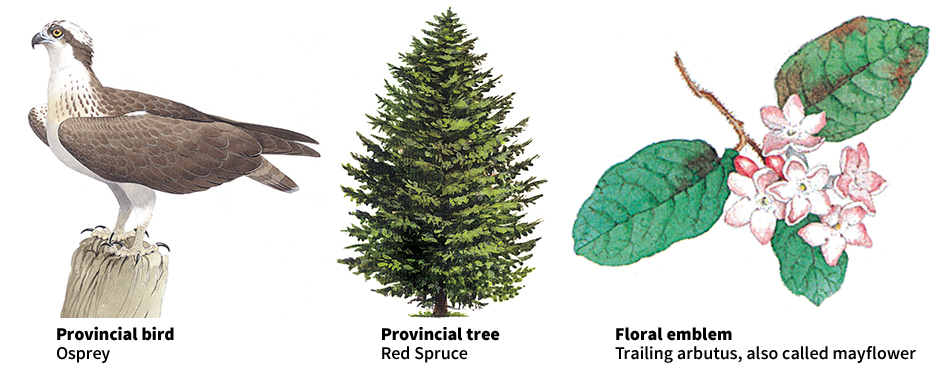
White-tailed deer roam the wilderness areas. Many kinds of sea birds nest along the shore and on offshore islands. Lobsters, scallops, and other seafood caught off Nova Scotia help make the province one of the leaders in the Canadian fishing industry.
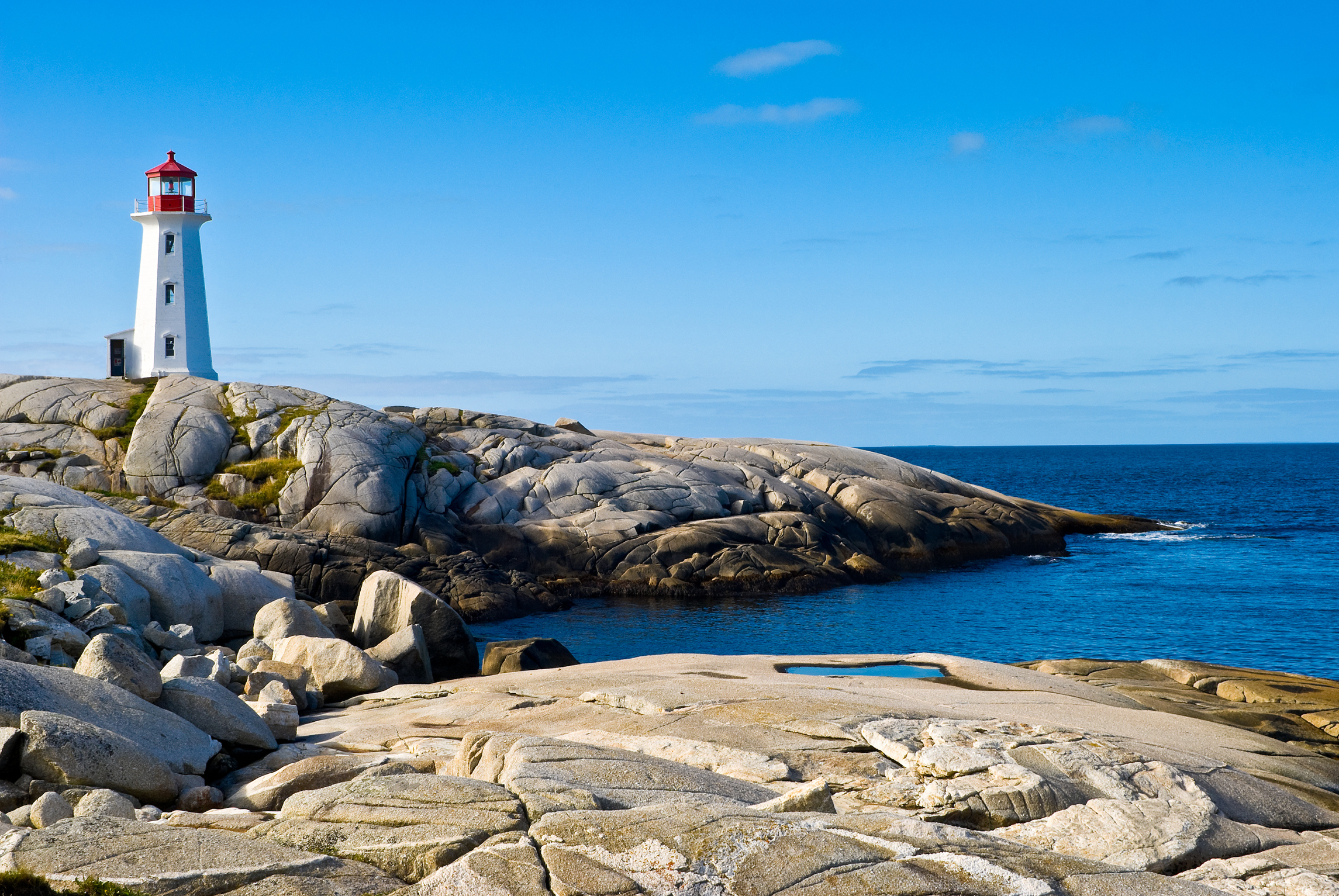
Service industries are the leading economic activity in Nova Scotia. These industries include education, government, and hotels and restaurants. Manufacturing is also important to the province’s economy. The leading products include food products, plastic and rubber products, and transportation equipment. Nova Scotia leads the provinces in mining gypsum.
People have lived in the Nova Scotia region for about 12,000 years. Indigenous (native) people, including the Mi’kmaq people, inhabited the area when European explorers arrived in the late 1400’s or early 1500’s. The first French settlement in Nova Scotia was on Sable Island in 1598, but it was short-lived. The French began to settle on the mainland in 1605, and arrived in greater numbers in the 1630’s. Scottish settlers first came to Nova Scotia in 1629. In 1713, Britain (now also called the United Kingdom) gained control of mainland Nova Scotia through a treaty with France. The Latin words Nova Scotia mean New Scotland, the name a Scottish charter gave to the region.
The American poet Henry Wadsworth Longfellow made Nova Scotia famous in his poem Evangeline (1847). The poem is an account of how British troops drove French colonists, called Acadians, from their homes in Nova Scotia in 1755. The poem gave the Annapolis Valley the nickname Land of Evangeline.
Beginning in 1749, settlers from Britain, Germany, and New England began coming to Nova Scotia in increasing numbers. During and after the American Revolution (1775-1783), many people who remained loyal to Britain fled from the United States to Nova Scotia. The settlers included many enslaved and free people of African descent. By the 1820’s, Nova Scotians had acquired the nickname “bluenosers,” which probably came from locally grown blue potatoes. Today, Nova Scotians still call themselves “Bluenosers.”
Nova Scotia, along with New Brunswick, Ontario, and Quebec, was one of the four original Canadian provinces. These four formed the Dominion of Canada in 1867. For the relationship of Nova Scotia to other provinces, see Atlantic Provinces; Canada; Canada, Government of; Canada, History of.
People
Population.
The 2021 Canadian census reported that Nova Scotia had 969,383 people. The population of the province had increased by about 5 percent over the 2016 figure of 923,598.
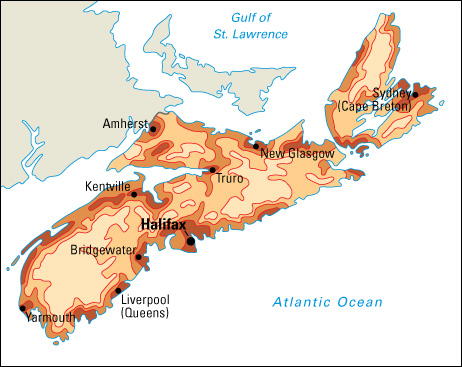
A majority of Nova Scotians have ancestors who originally came from the United Kingdom and Ireland. Significant numbers of others are of African, Dutch, French, German, and Mi’kmaq ancestry. A small number of people in Cape Breton still speak the Gaelic language of their Scottish ancestors. A larger number of Acadians and Mi’kmaq in Nova Scotia still speak French and the Mi’kmaq language, respectively.
Halifax is the capital of Nova Scotia and by far the largest of the province’s four regional municipalities. It includes the communities of Halifax, Dartmouth, and Bedford, and the surrounding area. Halifax is one of the most important ports in Canada, as well as the chief railway and air terminal in Nova Scotia. The Halifax metropolitan area is the province’s only census metropolitan area as defined by Statistics Canada (see Metropolitan area). It is home to nearly half of Nova Scotia’s people.
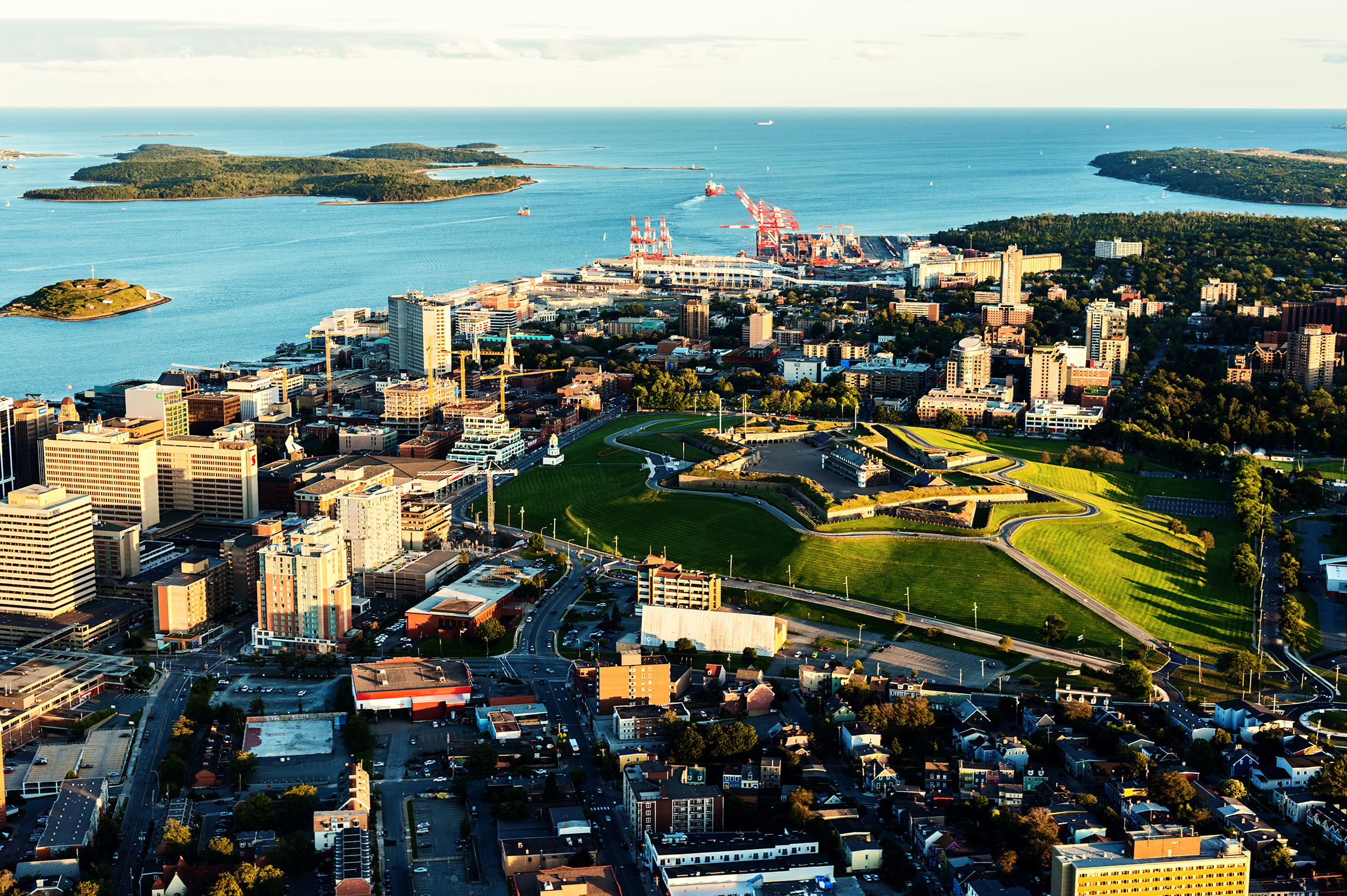
Nova Scotia’s second largest regional municipality by population is the Cape Breton Regional Municipality. It is on Cape Breton Island and includes the communities of Sydney and Glace Bay. The province’s other regional municipalities have much smaller populations than Halifax and Cape Breton.
Schools.
Public schools in Nova Scotia operate under the provincial Education Act. Nova Scotia’s first Education Act was passed in 1766. The provincial Department of Education and Early Childhood Development has general supervision of the public school system. Provincial and municipal governments fund the public schools. The federal government also provides funding for certain programs. Provincial law requires children to attend school from age 5 to age 16. Alternatives to public education include private schools and home schooling, which are both subject to provincial standards. 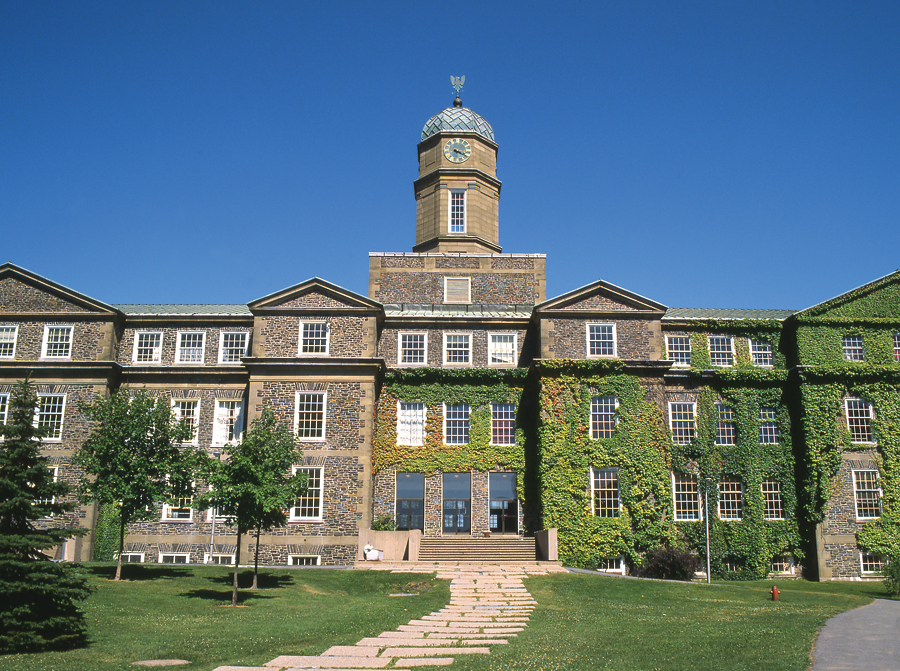
Libraries.
Nova Scotia has nine regional library systems and a number of college and university libraries. The Nova Scotia Provincial Library is in Halifax.
Museums.
The Nova Scotia Museum is a group of more than 25 museums and historic sites throughout the province. These include the Maritime Museum of the Atlantic and the Museum of Natural History, both in Halifax; the Fisheries Museum of the Atlantic in Lunenburg; and Sherbrooke Village, a restored town of the 1800’s, in Sherbrooke. Many of Nova Scotia’s Mi’kmaq communities have museums or cultural centers. The Black Cultural Centre for Nova Scotia, near Dartmouth, deals with the history of African Nova Scotians. Other museums include the Army Museum at the Halifax Citadel National Historic Site, a military fort of the 1800’s; and the Alexander Graham Bell National Historic Site in Baddeck.
Visitor’s guide
Nova Scotia’s beaches and shoreline resorts attract many visitors. Fishing enthusiasts catch haddock, mackerel, and striped bass along the coast, and salmon, shad, and trout in the streams. Visitors can also enjoy canoeing, hiking, sailing, sea kayaking, surfing, and whale watching. The province has many public and private parks and campgrounds. Halifax, the capital of Nova Scotia and one of the most historic places in Canada, has many historic buildings.

Nova Scotians enjoy festivities celebrating the many aspects of their heritage and their diverse backgrounds. The Antigonish Highland Games is a Scottish festival that takes place in Antigonish in July. Visitors listen to the sound of bagpipe music and watch the Scottish sport of tossing the caber, a heavy wooden pole. In this event, contestants throw a caber end over end as far as they can. Halifax hosts many festivals during the summer and fall. It is also the center of a vibrant year-round music scene. Winter sports in Nova Scotia include curling, hockey, skating, and skiing.
Land and climate
Land regions.
Nova Scotia has three main land regions. They are (1) the Atlantic Plateau, (2) the Northern Highlands, and (3) the Lowlands.
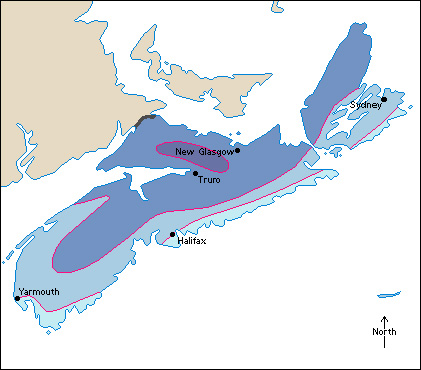

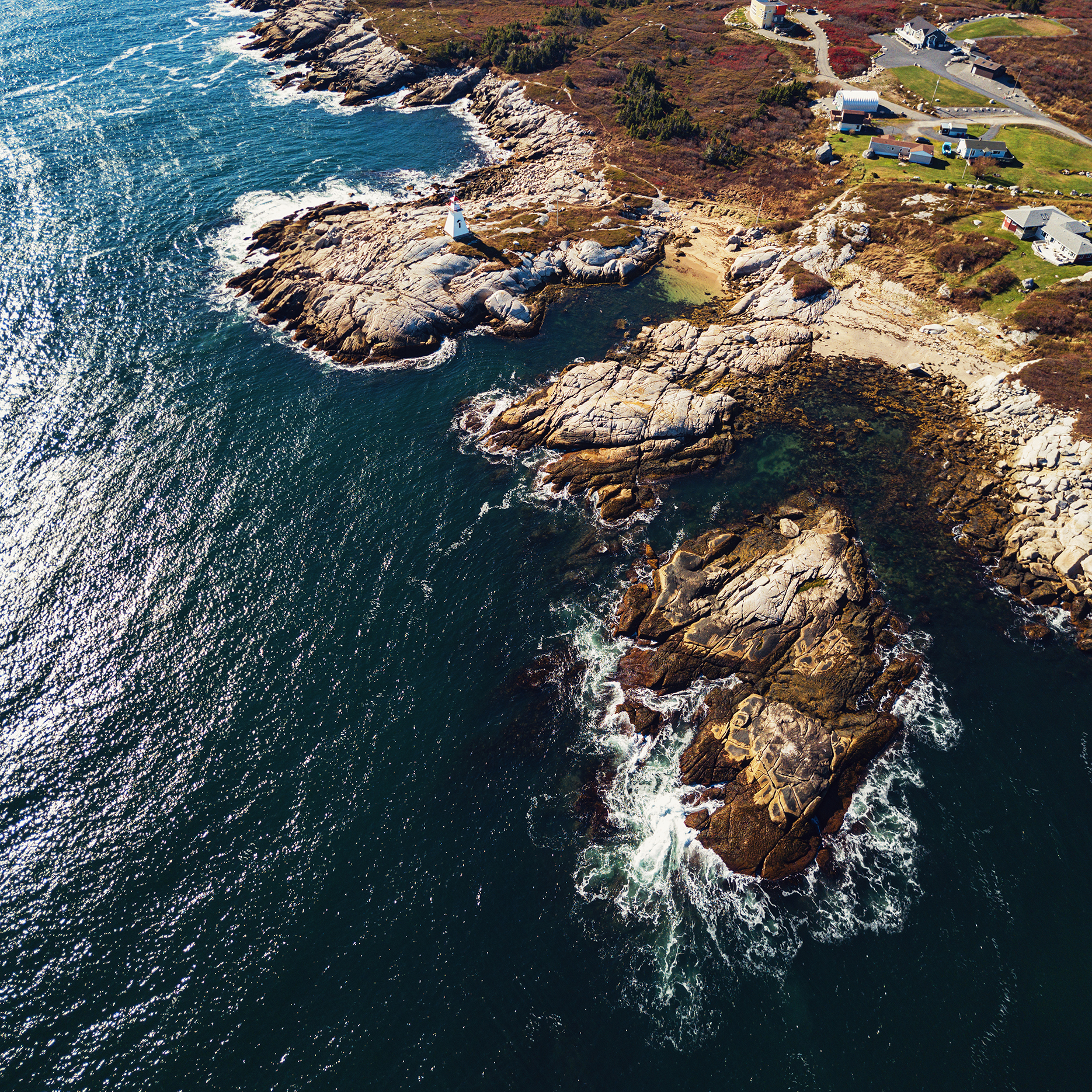
The Atlantic Plateau
rises gradually from sea level on the Atlantic coast to about 700 feet (220 meters) inland. Hard rocks from 400 million to 500 million years old lie beneath the surface of the region. These rocks were worn down to sea level to form a plain. About 70 million years ago, the plain uplifted slightly and tilted so that it sloped to the southeast. In the last ice age, which ended about 11,500 years ago, glaciers removed most of the topsoil, exposing bedrock in many places. The action of glaciers also created many lakes and bogs. Today, forests cover the Atlantic Plateau, and the land is unsuitable for farming.
The Northern Highlands
consist of masses of harder rocks that are generally over 400 million years old. These rocks form the rugged slopes of the Cobequid Mountains, the Pictou-Antigonish Highlands, and the Cape Breton Highlands. The highest point in Nova Scotia rises to 1,747 feet (532 meters) above sea level in Cape Breton Highlands National Park.
The Lowlands
lie mainly in central and northern Nova Scotia. Soft rocks about 200 million to 350 million years old lie beneath the surface of the region. They have worn down more rapidly than the harder rocks in the hills and plateaus of Nova Scotia’s other regions.
The Lowlands are gently rolling plains. They have Nova Scotia’s finest soils and mineral deposits. The rich farmland of the Annapolis Valley is south of North Mountain, which rises along the Bay of Fundy. Fertile marshlands, protected by dikes, lie at the head of the Bay of Fundy, along the inlets called Chignecto Bay and Minas Basin. These marshlands also extend far inland along many rivers. Beneath the Lowlands are rich deposits of coal and gypsum. There are also deposits of limestone, quartz, rock salt, sandstone, and shale.
Coastline
of Nova Scotia measures about 4,700 miles (7,600 kilometers). This includes about 2,500 miles (4,000 kilometers) of mainland, about 1,200 miles (1,900 kilometers) of major islands, and about 1,000 miles (1,600 kilometers) of minor islands. The rocky southern shore has many inlets. Fishing fleets use the large inlets as harbors. Hundreds of small islands lie off the southern coast.
Rivers and lakes.
Except for some broad estuaries (coastal river valleys flooded by the ocean), all of Nova Scotia’s rivers are narrow. Few rivers are over 50 miles (80 kilometers) long. The Mersey and the St. Mary’s rivers, both 72 miles (116 kilometers) long, are the longest in the province. The Mersey rises on South Mountain and flows through several lakes, including Lake Rossignol. Rich farmland lies along the Annapolis and Shubenacadie rivers, which flow into the Bay of Fundy. Other important rivers include the LaHave and Musquodoboit, which flow into the Atlantic, and the Margaree on Cape Breton Island. Many of Nova Scotia’s rivers rise and fall with the tides near their mouths, and carry salt water inland. Dikes around the Bay of Fundy and the Minas Basin, and along nearby rivers, protect farmlands from flooding at high tide.
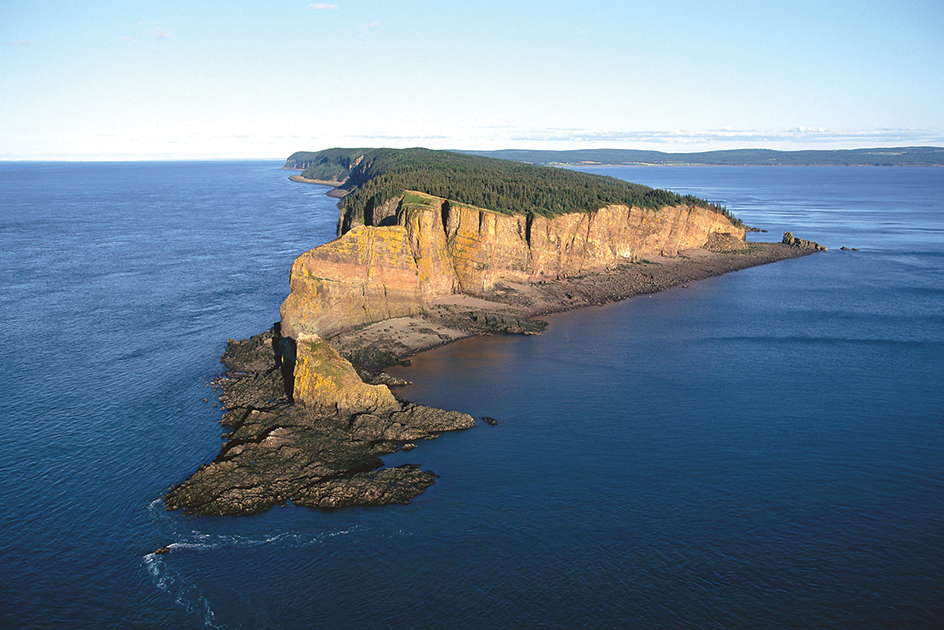
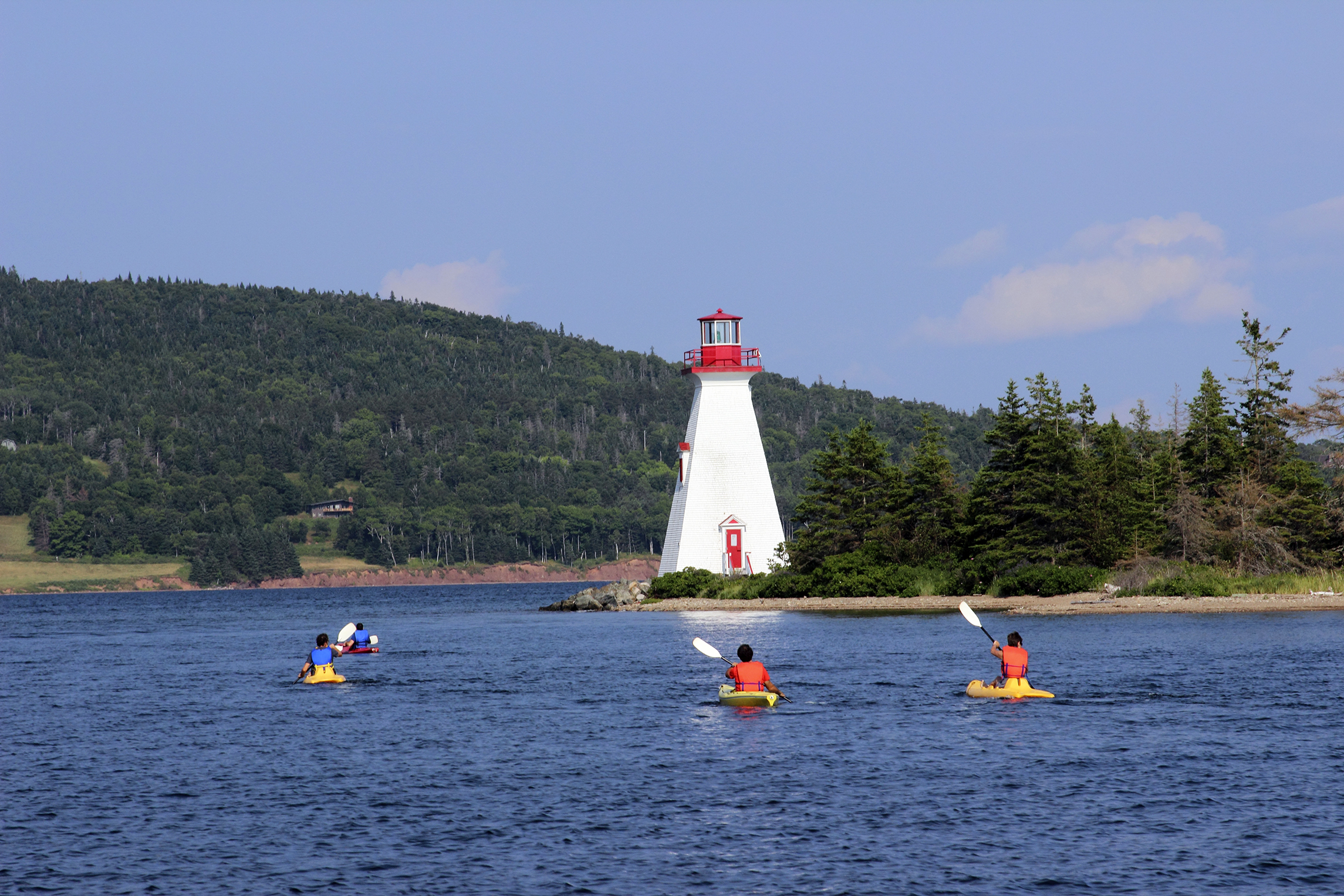
Nova Scotia has thousands of lakes, mostly on the Atlantic Plateau. Most of them are small. Bras d’Or Lake, the largest, covers 425 square miles (1,100 square kilometers) on Cape Breton Island. This saltwater lake with links to the ocean nearly divides the island in two. The largest freshwater lakes are, in order of size, Lake Rossignol in Queens County, Lake Ainslie and Mira River on Cape Breton Island, Kejimkujik Lake in Queens and Annapolis counties, and Grand Lake near Halifax.
Plant and animal life.
Forests cover most of Nova Scotia. Birches, firs, maples, pines, and spruces are the most common trees. Other plants found in the province include the blueberry, bracken, lambkill, raspberry, rhodora, sweet fern, trailing arbutus or mayflower, and wintergreen.
The white-tailed deer is Nova Scotia’s most common large animal. Some black bears, coyotes, moose, and wild cats also live in wilderness areas. Small animals of Nova Scotia include beavers, minks, muskrats, otters, porcupines, red foxes, skunks, and weasels. The province has several kinds of geese and ducks, as well as pheasants, ruffed grouse, and woodcocks. Salmon and trout swim in the streams of Nova Scotia. The coastal waters of the province contain clams, crabs, flounder, haddock, halibut, herring, lobsters, mackerel, pollock, redfish, scallops, and swordfish.
Climate.
The sea nearly surrounds Nova Scotia and keeps the climate from becoming extremely hot or cold. The province has an average January temperature of 23 °F (–5 °C). The average July temperature is 64 °F (18 °C). The Atlantic coast is the coolest area of Nova Scotia in summer, but it has the mildest temperatures in winter. The interior and north have hotter summers and colder winters. But even in these areas, winter temperatures seldom fall below 0 °F (–18 °C). In winter, winds crossing the ice-filled Gulf of St. Lawrence chill coastal areas of the northern mainland and western Cape Breton Island.
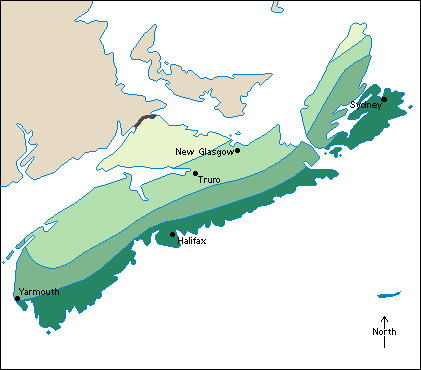
In spring and early summer, fogs are frequent along the Atlantic and Fundy coasts. Late summer and autumn bring sunny skies and pleasant southwesterly winds to the southern coast of the province.
Nova Scotia’s precipitation averages 53 inches (135 centimeters) a year. Rainfall in the province is heaviest along the Atlantic coast. Annual snowfall is highest where onshore winds blow onto highlands and is greater than 110 inches (280 centimeters) in the Cape Breton Highlands.
Economy
The vast majority of Nova Scotia’s workers are employed in service industries, which include education, finance, health care, tourism, and trade. Nova Scotia also has important manufacturing and fishing industries.
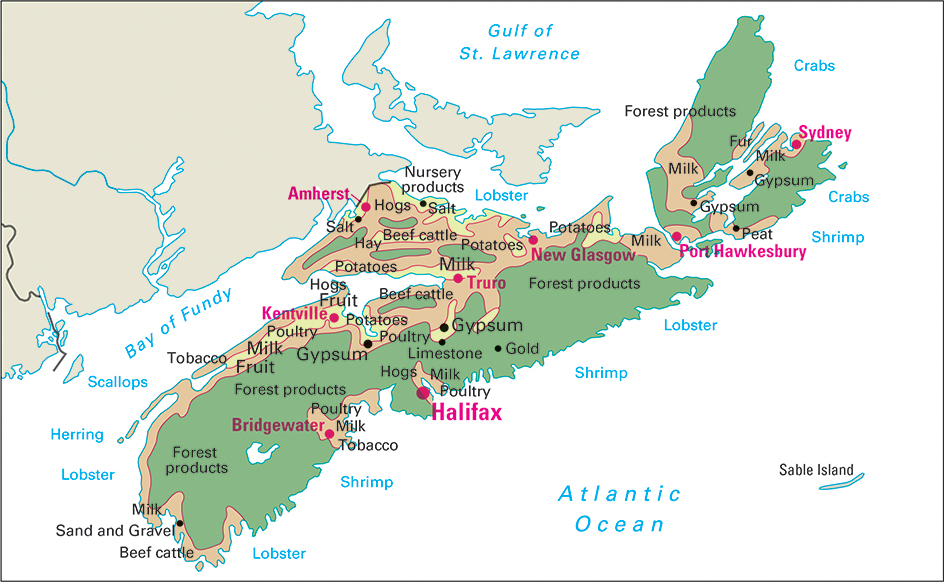
Natural resources.
Nova Scotia’s most valuable resources include its mineral deposits, forests, and fertile lowlands.
Soil.
The Annapolis Valley has Nova Scotia’s best farmland. Other good farming areas include reclaimed marshlands at the head of the Bay of Fundy, the central lowlands near Truro, and the coastal lowlands along the Northumberland Strait. The Northern Highlands and Atlantic Plateau regions have shallow, rocky soil.
Minerals
in Nova Scotia include two of North America’s largest deposits of gypsum, at Windsor and East Milford. Although the province’s last underground coal mine closed in 2001, significant coal deposits can still be found underground from Springhill on the Nova Scotia mainland to Glace Bay on Cape Breton Island. A few small surface coal mines still operate in Nova Scotia. Natural gas and oil deposits lie beneath the shallow waters around Sable Island. Other important mineral resources include barite, gold, limestone, salt, and sand and gravel.
Service industries,
taken together, produce the largest portion of Nova Scotia’s gross domestic product (GDP)—the total value of all goods and services produced in the province in a year. Service industries employ a large number of Nova Scotians. Many of these industries are in the Halifax area.
Halifax, the provincial capital, is the center of federal and provincial government activities. The Halifax area is the largest financial center in the Atlantic Provinces. The city is also the center of trade and tourism in Nova Scotia. A large naval base operates at Halifax.
Manufacturing.
Much of Nova Scotia’s manufacturing industry is centered on processing the province’s natural resources. Food and beverage processing is a leading activity. Food products include bakery goods, dairy products, fish products, and meat and poultry products. The manufacturing of wood and paper products is also important to the province.
Establishments in Nova Scotia also manufacture aerospace products, aircraft parts, boats, and ships. Large tire plants operate in the province. Nova Scotia also produces cement and concrete, electronics, and machinery.
Fishing.
Nova Scotia ranks first among the provinces in the value of fish caught. Lobsters are Nova Scotia’s most valuable catch. Scallops and snow crabs also are important. The once-important cod stocks have been greatly depleted. Aquaculture (fish farming) has become increasingly important in sheltered waters along the Atlantic coast and Bras d’Or Lake. 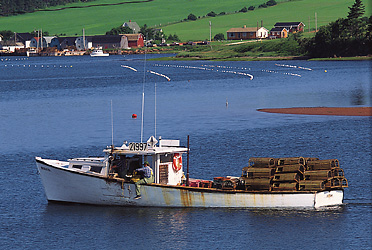
Mining.
Nova Scotia’s valuable mineral products include gold, gypsum, and salt. Nova Scotia is the leading province in gypsum production. A gold mine opened in 2017 at Moose River in central Nova Scotia.
Agriculture.
Livestock and livestock products provide the largest part of the province’s farm income. Milk is the leading farm product. The chief dairying regions are in Colchester County and the Annapolis Valley. Other important farm products in the province include beef cattle, chickens and eggs, and hogs.

Apples, blueberries, strawberries, and wine grapes are among the most valuable fruits. The raising of floriculture (ornamental plants) and nursery products is also important. Christmas tree nurseries are a leading part of this sector.
Forestry.
Nova Scotia’s forests supply wood for its pulp and paper mills, lumber mills, boatyards, and furniture factories. Maples and birches are the chief hardwoods of the province. The chief softwoods include balsam fir and spruces.
Electric power and utilities.
Power plants fueled by coal, natural gas, and oil generate much of Nova Scotia’s electric power. Hydroelectric plants and wind-powered plants supply most of the rest. The first tidal power plant in North America operates at the mouth of the Annapolis River.
Transportation.
Major provincial highways connect locations throughout Nova Scotia. Older scenic roads run mainly along the coastal areas. Part of the Trans-Canada Highway stretches from Amherst to North Sydney. Motor vehicles travel from the Nova Scotia mainland to Cape Breton Island over a causeway (elevated road), 11/2 miles (2.4 kilometers) in length, across the Strait of Canso.
Halifax has the province’s largest airport and seaport. It is a port of call for many cruise ships. Sydney and Yarmouth also have airports. Railways link some of Nova Scotia’s largest cities to a national railroad network. Ferries connect Nova Scotia with other provinces and Maine.
Communication.
The Halifax Gazette, founded in 1752, was the first newspaper published in Canada. It is still published as the Royal Gazette by the provincial government. Daily newspapers with the largest circulations are The Chronicle Herald of Halifax and the Cape Breton Post of Sydney.
The province has a number of radio and television stations. Cable television systems service most communities. The first radio station, CHNS, began broadcasting from Halifax in 1926. The first television station, CJCB-TV, began operating in Sydney in 1954.
Government
Lieutenant governor
of Nova Scotia represents the British monarch, Canada’s official head of state, in the province. The governor general in council—that is, the governor general of Canada acting with the advice and consent of the Cabinet—appoints the lieutenant governor on the recommendation of the prime minister. The position of lieutenant governor is largely honorary and symbolic.

Premier
of Nova Scotia is the actual head of the provincial government. Nova Scotia, like Canada itself, has a parliamentary form of government. The premier is an elected member of the House of Assembly. The person who serves as premier is usually the leader of the majority party in the Assembly.
The premier presides over a cabinet called the Executive Council. The cabinet is made up of the premier and other ministers. All the ministers belong to the Assembly’s majority party. They are chosen by the premier. Each cabinet member usually directs one or more governmental departments. The cabinet resigns if it loses the support of a majority of the Assembly.
House of Assembly
makes the provincial laws. This one-house legislature has 55 members who are elected by the people. An election for the Assembly must be held at least every five years. But the lieutenant governor, on the advice of the premier, may call for an election at any time. A premier who loses the support of the majority of the House of Assembly must resign. 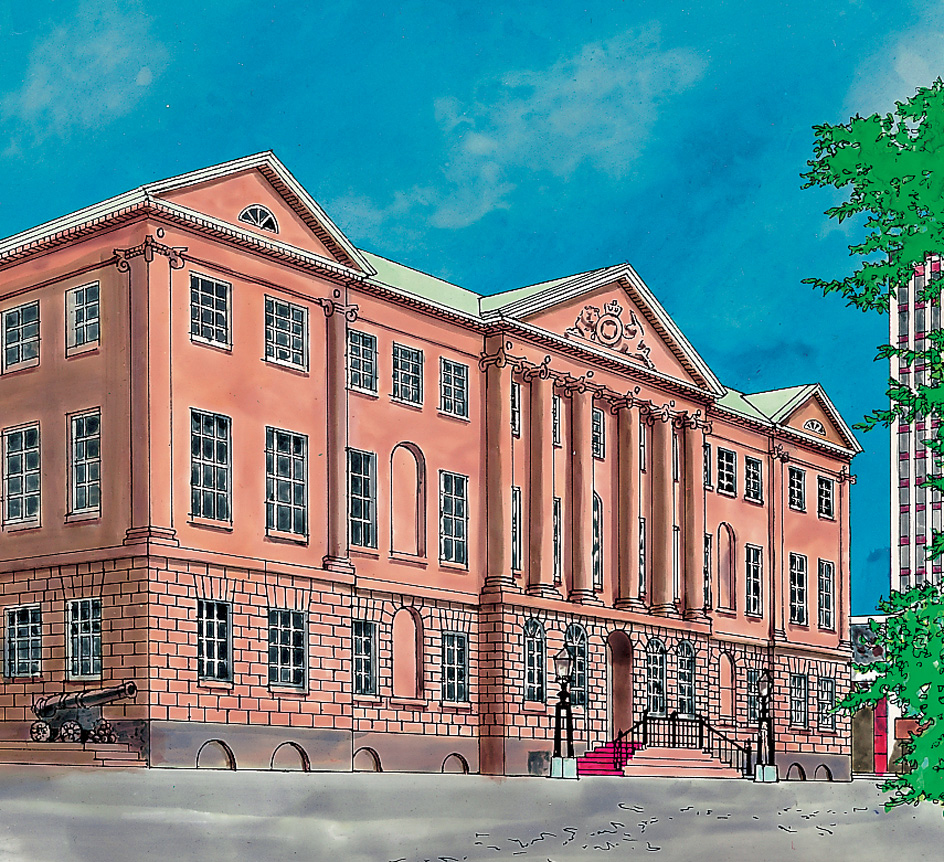
Courts.
Nova Scotia’s Supreme Court is the highest trial court in the province. Other courts include provincial, small claims, family, bankruptcy, and probate courts.
Judges of the Court of Appeal and the Supreme Court are appointed by the federal government and may serve until the age of 75. The provincial government of Nova Scotia appoints other provincial judges and justices of the peace, who may serve until the age of 70.
Local government.
Nova Scotia has 18 counties and a number of towns. Nine of Nova Scotia’s counties are single rural municipalities, six are divided into two rural municipalities apiece, and the other three are regional municipalities. Voters from each regional municipality and town elect a mayor and a council. An elected council governs each rural municipality. Members of the council, called councilors, elect a warden (chief councilor) from their group.
Revenue.
Nova Scotia gets about half of its general revenue (income) from taxes levied by the provincial government. Most of this money comes from taxes on income and on goods and services. Sales of gasoline and tobacco products are also taxed. Other sources of revenue include national and provincial tax-sharing programs and license and permit fees.
Politics.
Nova Scotia’s leading political organizations are the provincial Liberal, New Democratic, and Progressive Conservative parties. Since July 1867, when Nova Scotia became a province, Liberals have controlled the government longer than any other party.
History
Early inhabitants.
Human beings have inhabited Nova Scotia for approximately 12,000 years. The earliest people, whom archaeologists call Paleo-Indians, were hunters who lived mainly off herds of caribou. They are considered the ancestors of the modern Mi’kmaq. When Europeans first reached Nova Scotia and other parts of Atlantic Canada, the Mi’kmaq lived across the region along with the Beothuk and Maliseet (also called Wolastoqiyik), two other First Nations peoples. First Nations are original peoples of the land that is now Canada. At that time, the Mi’kmaq called themselves L’nuk, meaning the people. The name Mi’kmaq came from a greeting—nikmaq—that Europeans heard the people use. The region’s early inhabitants hunted and fished along the coast in the summer and in the forested interior during the winter. See Beothuk; First Nations; Mi’kmaq.
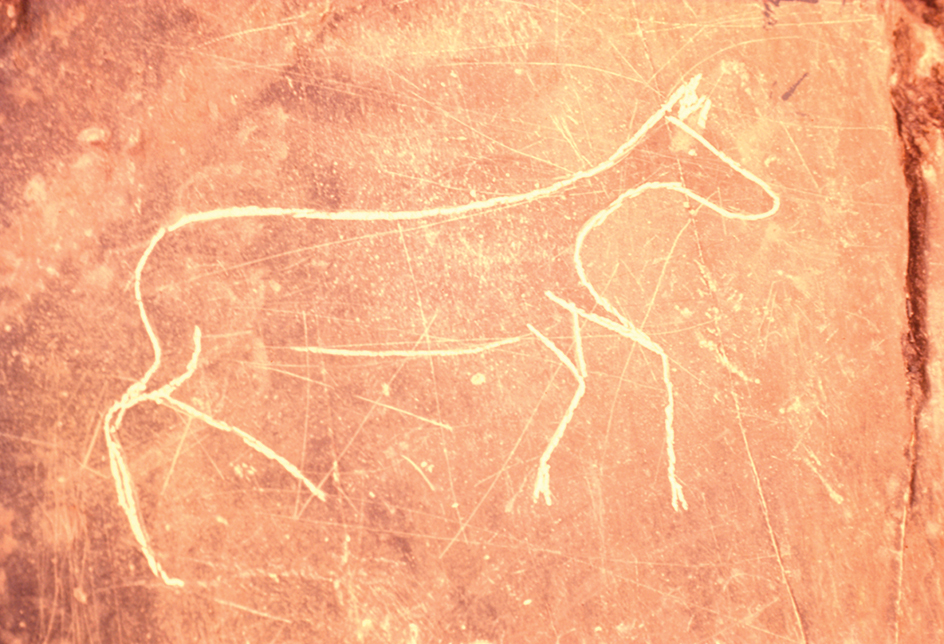
Exploration and settlement.
In 1497, John Cabot, an Italian navigator in the service of England, landed on Cape Breton Island or Newfoundland. Cabot believed he had landed in Asia. Between 1520 and 1524, other European explorers sailed through Nova Scotia waters while trying to find a westward sea route to Asia. They included the Italian navigator Giovanni da Verrazzano and two Portuguese sailors, João Alvares Fagundes and Esteban Gómez (also spelled Estêvão Gomes). Verrazzano explored in the service of France. Gómez sailed in the service of Spain. Some historians think that Fagundes founded a colony on Cape Breton Island. During the summers of the late 1500’s, French and Basque fishing crews used Nova Scotia’s harbors for drying codfish they had caught offshore. These crews returned to France every autumn.
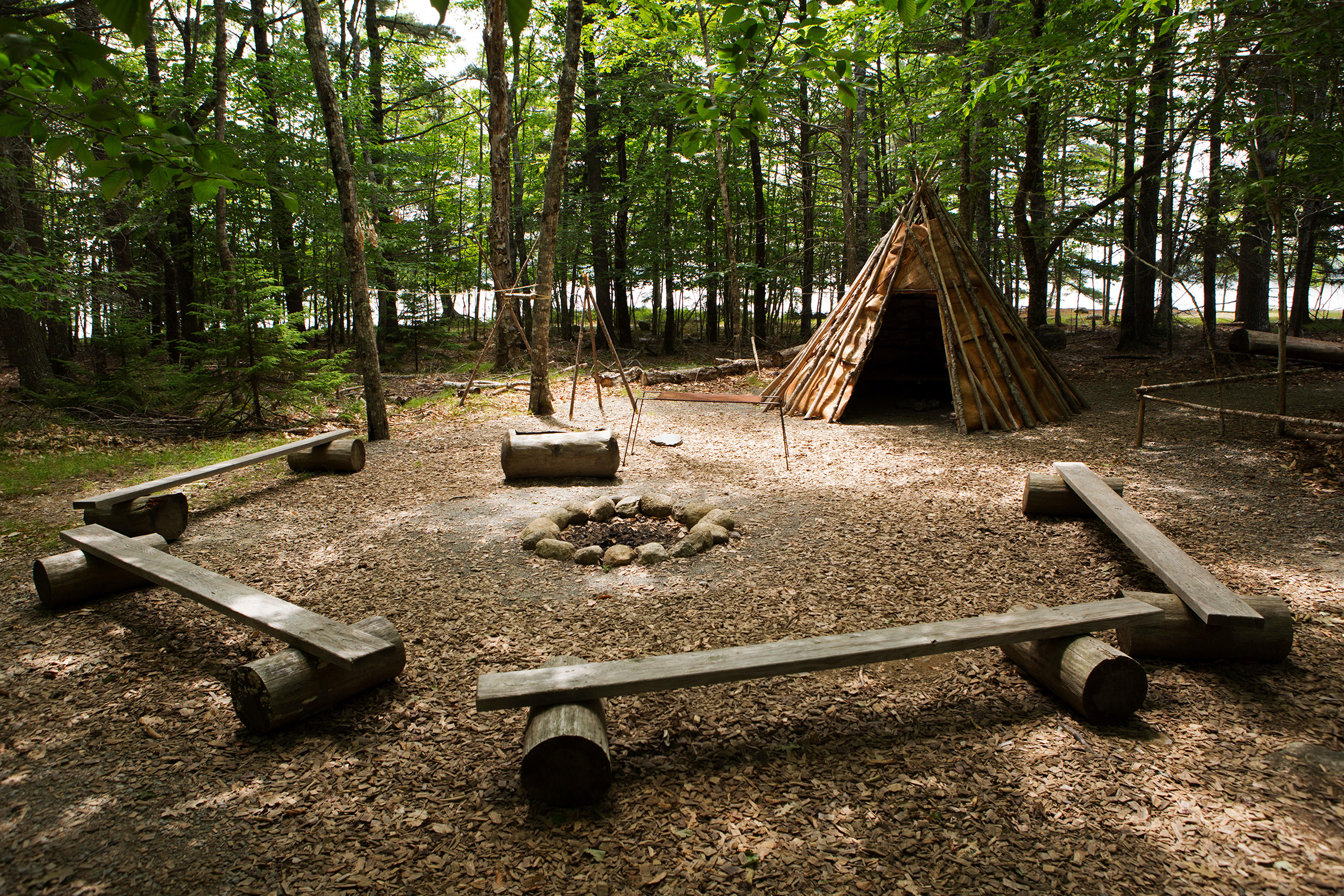
In 1598, King Henry IV of France granted a fur-trading monopoly in a vast area of Atlantic Canada to a French nobleman, the Marquis de La Roche-Mesgouez. La Roche accompanied an expedition of about 50 men to Sable Island, which he named the Île de Bourbon. La Roche returned to France later that year, but the other men stayed on the island. Many of the men died, but a few survivors made their way back to France in 1603.
In 1603, King Henry granted land and trading rights over an area that included Nova Scotia to the French nobleman Pierre du Gua (or du Guast), Sieur de Monts. De Monts and other explorers, including Samuel de Champlain, sailed together along the coast of what is now Nova Scotia, New Brunswick, and Maine in 1604. Champlain made the first accurate charts of the coast. The Nova Scotia region and the land around it became known as Acadie or Acadia.
De Monts first established a base at the mouth of the St. Croix River, which separates New Brunswick from Maine. In 1605, after a difficult winter, the base was moved to Port-Royal, near present-day Annapolis Royal. The new settlement served as an outpost for trading fur with the Mi’kmaq and as a base for French missionaries. In the years that followed, Chief Membertou and many other Mi’kmaq blended the settlers’ Roman Catholic faith with their own traditional spiritual beliefs. 
The struggle in Acadia.
In 1613, an English expedition from Virginia burned the French settlement at Port-Royal. Samuel Argall, a sea captain, led the attack. For the next 150 years, the English and the French battled, off and on, for control of Acadia.
In 1621, King James (who ruled as James I in England and James VI in Scotland) made a land grant to the Scotsman Sir William Alexander. The grant included what are now Nova Scotia (including Cape Breton Island), New Brunswick, Prince Edward Island, and parts of Quebec and Maine. The charter granted by the king called the region Nova Scotia, Latin for New Scotland. In 1629, Alexander’s son, Sir William the younger, built Charles Fort near the site of the former French settlement at Port-Royal. The colony lasted until 1632, when a peace treaty returned control of Acadia to France. Colonists sent by a French company took control of the Port-Royal area but settled primarily at LaHave, on Nova Scotia’s southern coast. Around 1636, many of these settlers relocated to the Port-Royal area, which had better potential for agriculture. Their main settlement, called Port-Royal, was about 10 miles (16 kilometers) from the original Port-Royal settlement. By building dikes, they reclaimed marshland from the sea for farming.
English troops under Sir William Phips captured Port-Royal in 1690. But England gave Port-Royal back to France under the Treaty of Ryswick in 1697. A combined force of British troops from England and New England took Port-Royal again in 1710. That year, the British changed the name of Port-Royal to Annapolis Royal after their queen, Anne. It became the capital of the colony in 1713.
France gave up the mainland of Nova Scotia to Britain under the Treaty of Utrecht in 1713. Neither this treaty nor any before it involved the Mi’kmaq or the Maliseet. The region’s Indigenous peoples later signed treaties for “peace and friendship” with the British Crown, but they never agreed to surrender any territory.
The 1713 Treaty of Utrecht made British subjects of the Acadians who remained in Nova Scotia. It also allowed France to keep Île Royale (now Cape Breton Island) and Île Saint-Jean (now Prince Edward Island). Both Britain and France claimed authority over most of what is today New Brunswick. The French built a fortified town at Louisbourg on Île Royale to assert their power in the region. Troops from New England, an area controlled by Britain, captured the fortress in 1745 with the aid of Britain’s Royal Navy. France regained it in 1748 under the Treaty of Aix-la-Chapelle, which settled a European war. But Louisbourg again fell to the British in 1758, during the Seven Years’ War (1758-1763).
British settlers established Halifax in 1749, and it became the new capital of Nova Scotia the same year. Many French, German, and Swiss Protestants moved to Nova Scotia during the early 1750’s. 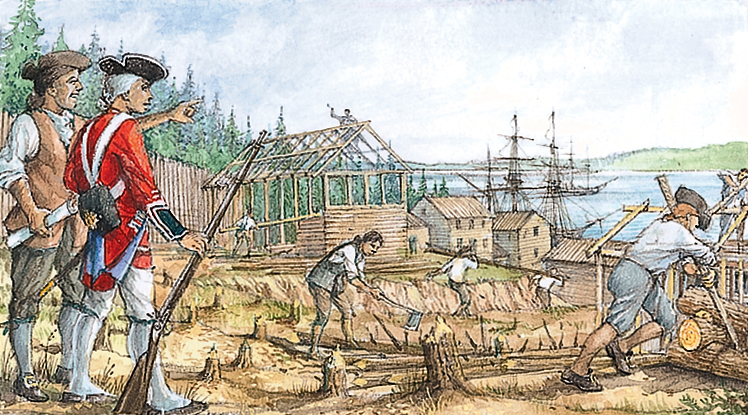
In 1755, the Nova Scotia Council ordered the deportation of all Acadians. At the time, Britain and France officially were at peace. But each nation sought to expand its presence in North America, and the council doubted the Acadians’ loyalty to Britain. In the following years, until 1763, troops from Britain and New England forcibly removed about 10,000 Acadians from Nova Scotia, Île Saint-Jean, and Île Royale. At first, they sent the Acadians to Britain’s American Colonies. Later, they sent them to France. Diseases and shipwrecks took the lives of many Acadians during this upheaval. After 1763, Acadians were allowed to return to Nova Scotia provided that they swore an oath of loyalty to Britain. Many Acadians migrated on their own to Louisiana from about 1763 to 1785.
Also during the 1700’s, the British agreed to a series of peace and friendship treaties with the Mi’kmaq. These treaties, signed from 1725 to 1779, today form the basis for land claims by the Mi’kmaq.
Progress as a province.
In 1758, after the British captured Louisbourg, the British government allowed colonists in Nova Scotia to elect a representative assembly. The first assembly met in Halifax. It gave the people some voice in their government, but a governor and a council appointed by the king continued to rule the province. In 1763, under the Peace of Paris, France officially gave up Cape Breton Island (formerly Île Royale) and St. John’s Island (formerly Île Saint-Jean) to Britain, and they became part of Nova Scotia. St. John’s Island became a separate colony in 1769, and its name was changed to Prince Edward Island in 1799. Cape Breton Island existed as a separate colony from 1784 to 1820, when it once again became part of Nova Scotia.
In 1760, more than 20 ships carrying New Englanders arrived in Nova Scotia. These people, referred to as New England Planters, took over the fertile marshlands the Acadians had reclaimed. They also established many new settlements.
During and after the American Revolution (1775-1783), about 35,000 people came to Nova Scotia from the United States. Most of these people, called Loyalists or United Empire Loyalists, were British colonists in America who refused to take up arms against Britain in the war. They established Saint John (now in New Brunswick) and Shelburne and also settled in Guysborough, Digby, and other towns. About 3,500 of the Loyalists who went to Nova Scotia were African Americans who had been promised freedom from slavery. There also had been some Black settlers among the New England Planters. Many Loyalists settled in the area that is now New Brunswick. The British had ruled this area as part of Nova Scotia since 1763. In 1784, they made New Brunswick a separate colony to make it easier to administer.
Protestant and Roman Catholic settlers from Scotland began arriving in eastern Nova Scotia in 1773. They continued to immigrate in large numbers for over 50 years, becoming a major group in what later became Pictou and Antigonish counties. Irish Catholic immigrants also arrived in the early 1800’s, settling chiefly in and around Halifax. More African Americans arrived from the United States during the War of 1812 (1812-1815), again seeking freedom from slavery.
In 1848, the British government gave Nova Scotia’s elected representative assembly authority over the colony’s executive cabinet. Thus, Nova Scotia became the first British colony with responsible government, under which an elected legislative assembly had chief authority over local affairs. Joseph Howe, a forceful editor and statesman of Nova Scotia, had led the fight for this form of partial self-government.
During the 1800’s, Nova Scotia thrived with growing industries and increasing world trade. Shipbuilders used timber from the province’s forests to build merchant ships. By 1860, Nova Scotia had one of the largest merchant fleets in the world.
In 1867, Nova Scotia joined with New Brunswick, Ontario, and Quebec in forming a confederation called the Dominion of Canada. But many Nova Scotians opposed the union and soon voted out the leaders who had supported confederation. Many Nova Scotians preferred to remain proud members of the British Empire rather than become part of the new Canada. 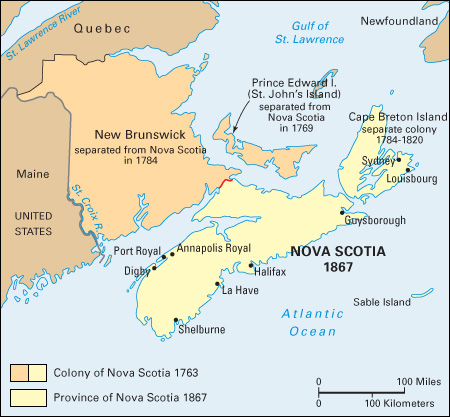
The next 25 years were a period of economic hardship for Nova Scotia. Investors abandoned shipping in an unsuccessful effort to industrialize the province. During the late 1890’s, however, Nova Scotia’s coal and steel industries began to thrive.
The early to middle 1900’s.
During World War I (1914-1918), Halifax served as the headquarters of Allied convoys sailing between North America and Europe. In 1917, the Mont Blanc, a French ship carrying explosives, collided with the Imo, a Norwegian vessel, in Halifax Harbour. The resulting blast, known as the Halifax explosion, killed about 2,000 people, injured thousands more, and damaged much of the city.

Following World War I, Nova Scotia experienced an economic crisis and political unrest. Many people left the province. After a brief period of prosperity during World War II (1939-1945), hard times returned.
In the mid-1950’s, Canada’s overall postwar prosperity began to trickle down to Nova Scotia, and the provincial economy grew. Schools, hospitals, and modern roads were constructed. The Nova Scotia section of the Trans-Canada Highway was built. In 1955, the Canso Causeway, linking the mainland and Cape Breton Island, was completed. It contributed to the province’s economic growth and an expansion of the tourist industry. During this period, the rural population of Nova Scotia declined as people moved to the province’s urban areas.
Beginning in the 1950’s, Canada’s federal government and Nova Scotia’s provincial government worked to promote economic growth within Nova Scotia. A series of provincial and federal agencies sought to close outdated industries and attract new ones. These agencies included Industrial Estates Limited (established in 1957), the Cape Breton Development Corporation (1967), Sydney Steel Corporation (1969), and Nova Scotia Power Corporation (1973).
The expansion of industry and port facilities helped improve Nova Scotia’s economy in the 1970’s. For example, a container terminal opened in 1970 at the Port of Halifax to handle large container ships. During the early 1970’s, an industrial park was built on the shores of the Strait of Canso.
The late 1900’s and early 2000’s
saw several important economic developments in Nova Scotia. Expanded and upgraded facilities at the Port of Halifax enabled the province to handle increasing amounts of cargo, especially shipping containers. In 1995, the government legalized gambling casinos to provide a new source of income for the province. The production of natural gas, which had been discovered in the 1970’s near Sable Island, began in 1999 and continued through 2018. Cruise ships also brought many tourists to the province, especially Halifax.
However, the province also faced economic challenges. During the 1990’s, efforts to balance the federal budget led to reduced funding for Nova Scotia. As a result, government enterprises were cut back. Some municipal governments, hospital and school boards, and institutions of higher education were combined in an effort to save money. In 1992, the government sold Nova Scotia Power, the province’s main provider of electric service, to private investors. In addition, Atlantic Canada’s cod-fishing industry virtually collapsed because of overfishing.
In 2009, Nova Scotia voters elected the first New Democratic government in the province’s history. Previously, the Progressive Conservative and Liberal parties had dominated provincial politics.The New Democrats governed through 2013, when they lost the next general election.
In April 2020, Nova Scotia became the site of one of the worst mass shootings in Canada’s history. A gunman impersonating a police officer killed 22 people at multiple locations in central Nova Scotia. Police then killed the gunman.
